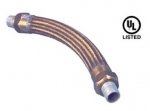I still have very strong doubts that the currently available conduit coupling can actually do that. There is little mass there as compared to an explosion proof enclosure and the tightness of the metal to metal in the conduit/coupling connection is much much less than in the connection between the explosion proof enclosure and its cover.
the entire point of a threaded fitting in a classified location,
is for there to be enough threads engaged, that
WHEN
the atmosphere inside the conduit/fitting/panel/whatever
explodes, and it will, the expanding burning gases will have enough
metal as a heat sink, to cool the burning gases below the
point of ignition of the surrounding atmosphere, before they
reach that atmosphere.
the rule of thumb is five full turns of engagement of the threads.
a CL I DIV I j box with a threaded cover doesn't have to be tightened
to work. five full turns is enough.
the reason running thread is not permitted, is the highly reduced wall
thickness of the running thread weakens the conduit excessively.
if the wall thickness wasn't an issue, running thread would be fine,
as long as 5 full turns of engagement were present.
with a flanged bolted enclosure, the thickness of the flange is enough
for the same cooling effect, when bolted. this is why any nicks, or bumps
on the flange are not a problem as long as they are stoned away, so the
surface mates completely. the flange isn't a seal, it's a heat sink.
this is why classified locations are gasket free. nothing that degrades over
time or repeated opening is used.



